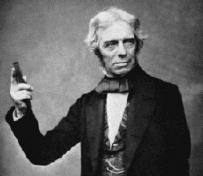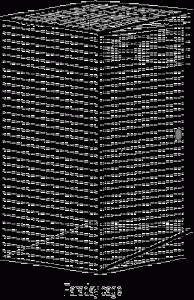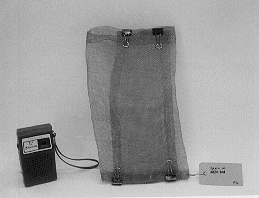[pullquote]Windshield Mount Cell Phone Holders can play a role in reducing invisible RF hazards and getting the best possible phone reception.[/pullquote]
The Faraday Cage (named after its discoverer) means that the electric charge on a conductor sits on the outer surface of it. Therefore, no electrostatic field is present within the conductor
FARADAY CAGE – RADIOWAVES
PURPOSE: To demonstrate that radio waves cannot penetrate a Faraday cage.
DESCRIPTION: The radio is tuned to a good station so that everyone can hear. Lowering the screen Faraday cage over the radio stops the radio waves, and the sound of the radio ceases.
FARADAY CAGE – ELECTROSCOPE
PURPOSE: To demonstrate that the electric field within a closed surface is zero.
DESCRIPTION: Charge the two wire strainers, which are connected electrically to the electroscope indicator. With the two meshes separated, the electroscope deflects. When they are placed together, forming a closed sphere, the electroscope deflection is zero, indicating zero potential within the closed cage.

Faraday Cage , A truly unique room called a Faraday Cage so named in honor of Michael Faraday who in 1831 discovered the principle of magnetic induction, and in 1836 described the Faraday Cage in his diary.
Michael Faraday
Faraday lived from 1791 to 1867 and is often considered to be the greatest experimentalist in the field of electricity and magnetism. He, along with others (such as Ohm, Volta, Coulomb, etc.) uncovered the relationships between the various experimental phenomena that lie at the foundation of the field. He championed the concept of magnetic “lines of force” to understand this body of work.
About this time, Reimann and Guass noted the similarity between athe phenomena of electricity and magnetism and that of gravity and were able to quickly borrow the mathematics from celestial mechanics and apply them to electromagnetism. Faraday did not like the approach of these Germans but he was not adept enough at mathematics to challenge their position. So he explained his ideas to a young Scottish mathematician named James Clerk Maxwell.
A truly unique room called a Faraday Cage so named in honor of Michael Faraday who in 1831 discovered the principle of magnetic induction, and in 1836 described the Faraday Cage in his diary.
Here, in Faraday’s own words from his diary of January 15, 1836 is his description of the first Faraday Cage:
“Have been for some days past engaged in building up a cube of 12 feet in the side. It consist of a slight wooden frame, constituting the twelve linear edges, held steady by diagonal ties of cord; the whole being mounted on four glass feet, 5.5 inches long, to insulate it. The sides, top and bottom are covered in with paper. The top and bottom have each a cross framing or tying of copper wire, thus; which with the diagonals of cord, support the two large sheets of paper which cover them in, the copper wires also serving to feed the paper surface with electricity. The framing at top and bottom, of copper wire, are connected by copper wires passing down the four corner uprights; and a band of wire also runs round the lower edge of the cube. The sheets of paper which constitute the four sides have each two slips of tin foil pasted on their inner surface, running up 3/4 of the height; and these are connected below with the copper wire so that all the metallic parts are in communication. The edges of the side sheets are fastened here and there by tacks or paste to the wooden frame at the angles, so as to prevent then flying out and so giving irregular dispersion of the electricity. The whole stands in the lecture room, one of the lower edges being within 5 inches of the third seat (on which the feet rest), and the opposite lower edge being sustained on stools and blocks, about 4 feet from the ground. The chandelier hangs nearly opposite the middle of the face of the cube at this side, being about 2.5 feet from it.”[1]
Faraday Cage
The Faraday cage is a practical application of the effect demonstrated in school as the Faraday ice-pail experiment. If an ice pail, or any other hollow conductor is given a charge on its inside, then the charge will spread all over the outside surface of the conductor in such a way as to produce no electric field inside. The Van de Graaff generator uses this effect to produce such a large potential on the outside surface of its dome. In large Van de Graaff generators it is possible to have a lab or office actually inside the dome, and even have people there, while the machine is on! The idea that a hollow metal conductor will protect the interior from electric fields can be used using Faraday screens, cans or cages.
A Faraday can is nothing more complicated that a metal biscuit barrel for example. If an electronic watch is placed inside such a container, and then a spark is drawn to the container either from a Van de Graaff generator or induction coil, then after the demonstration, the watch will be unharmed.
A more impressive demonstration of the Faraday cage effect is that of an aircraft being struck by lightning. This happens frequently, but does not harm the plane or passengers. The metal body of the aircraft protects the interior. For the same reason, and if it were not for the highly flammable nature of petrol, a car would be a very safe place to be in a thunderstorm.

To demonstrate the Faraday cage effect we have constructed a human-size Faraday cage which we allows someone to stand inside while the discharge from a Tesla coil is directed towards it. To increase the dramatic content of the demonstration, the person inside is asked to hold a fluorescent tube, which does not light, while similar tubes balanced against the sides of the cage do light when the discharge is enabled. Our cage measures 1m square and is 2m tall. It is built from 1cm pitch steel mesh. The mesh is secured to a strong ‘speedframe’ framework, and riveted all round the frame except for the door section which is hinged on, and has two retainer catches to ensure the door stays shut while the demonstration is taking place.








